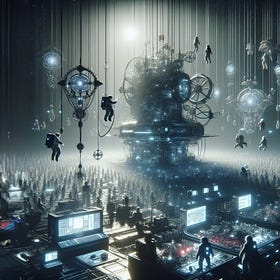The more accurately you miss, the more accurately you hit. (Virginia Woolf)
Perhaps the words we use to describe our own world are even more potent than the principles of reality itself – after all, they carry a trainload of ideas that are imposed as a priori assumptions on how we perceive the World. As an exemplar, take the term Capitalism. Here, the Latin root caput (= head) reveals we are dealing primarily with a figment of the imagination – so it’s no wonder that Marx introduces his readers to the world of fictional Capital. The same applies to system, which, as a composite (syn-hestenai), corresponds to Heidegger’s framework [Gestell] – referring to a logic that is at home in the world of technical design.1 And because this logic is supposed to lead to an »always already«, that is a perpetuum mobile, the systems theorist (=Luhmann) doesn’t shy away from imbuing his construct with an autopoietic, self-generating essential quality.2 According to Steve Jobs’ wonderful dictum (»The computer is the solution; what we need is the problem«), such terms go hand in hand with the solution to the problem – the thinker has acquired a passe-partout with which everything can be fitted into a wonderful framework. If, on the other hand, the reader is convinced that such things are nothing more than metaphysics, that history is full of fault lines which catapult us out of the eternal present, then the choice of words is crucial. Consequently, I’ve avoided metaphysically overloaded terms as much as possible—it just made more sense to me to think of society as a whole, as an operating system [Betriebssystem]. And indeed, when I first heard the word, it struck me as a perfect fit – after all, it made it clear that we’re dealing with a human, historical construct capable of undergoing radical change (a phenomenon that became apparent to me in our clashing with the Digitalised Order ). But the further I delved into the dark foundations of cultural history, the more urgent the question became of how our society can be understood as a whole conceptually. How, as an exemplative, can a system whose foundations are rooted in the unconscious be understood? Or, as the wonderful anthropologist Mary Douglas put it:
An institution is the answer to a question you can't remember asking.‹3
Consequently, because efforts are at work here that the actors may not be aware of—we can conclude that every Social Institution [gesellschaftliche Einrichtung] pushes its members to move forward in a particular direction [Richtung]. Keeping this in mind, it is clear that simply opting out of a particular social system isn’t an option; even more so: nolens volens, we must deal with the formations of unconscious assumptions. To address this linguistic problem and give the unconscious its rightful place, I decided to speak of a driving propulsion plant or engine [Triebwerk] –intentionally emphasizing the ambiguously shimmering, pulsating quality of this expression. Although the word evokes associations of a motor propelling a vehicle, such as with an airplane, in referencing the Gestalt of the drive [Trieb], it also refers back to humans: or more precisely, to their Psyche. Breaking the word down into its constituent parts, we find two mutually exclusive—or at least minimally complementary—components. The Trieb [drive] contains the momentum of forward movement, while the Werk [work] refers to the created, the human artifact. This conflict becomes even more intense when we add Freud’s drive theory to the mix, which suggests that the motivations for certain behaviors lie deeply buried in the unconscious. The tension between the unconscious and the instrumentalization of the Triebwerk marks the intellectual challenge, which necessarily leads to the task of understanding society within the context of a coherent whole: as a social drive [Gesellschaftstriebwerk]. Following this line of thought, several curious overlapping patterns come to light. It isn’t particularly remarkable to attribute specific historical driving forces to our inner life, such as tact and punctuality – and this often leads us to describing certain libidinal urges in a dehistoricized way as being instinctual [triebhaft]. How far this misses the point becomes clear when you consider that tact and punctuality—cardinal virtues of Capitalism—owe their existence solely to the mechanical clock, which in turn can be traced back to the Universal Machine of the Middle Ages, the Wheelwork mechanism [Räderwerkmechanismus].
Now, even work itself, even if considered a human artifact par excellence, isn’t immune to such ambiguity. Because if we add its ancient Greek counterpart, ergon, it is only a short step to arrive at the concept of energeia—and there it would be obvious to focus not on the creator, but on the material making such a work possible in the first place. To see how shortsighted this thinking is, look no further than today’s discourse, which, in its distinction between clean and toxic (fossil) energy sources, pays homage to a strange form of energy Manichaeism—a way of thinking that completely misses the point made by its author (who was, incidentally, a contemporary of his time). The word itself demonstrates just how misleading such thinking is. Because before energy could be hidden away in a wall socket, that is, in a conceptual black box, energeia meant first and foremost: to be at work. With this sequence in mind, it can only be concluded that the meaning of energy is derived from that of work, with which the concept of driving force [Triebkraft], as human productivity, takes on an energetic aspect. This thought became even more salient when, while analyzing the Alphabet, I was confronted with the insight that the Alphabetic Signs owe their existence to the Bronze Age’s metallurgical revolution. When Hesiod begins his Works and Days [Érga kaí hēmérai] with the sequential progression of metallurgical ages, the golden, silver, and bronze eons, this is no coincidence—because every driving force [Triebwerk] is deeply connected to an energetic question. And because the ancient Greek metallurgists had solved the problem of matter insofar as they were able to cast any shape they wanted—as sculptures that would last for generations—they were also able to cast the ideal athlete as a corresponding form, who took on the role of a sex symbol, representing a form of desire. In this sense, the drives [Triebwerk] that a society produces cannot be understood solely as mechanical means of propulsion, but always represent psychological driving forces [Triebfedern] which deeply influence the lives of its individuals. As the athlete’s physique clearly shows, we’re always dealing with a kind of formatting here—indeed, the sum of these formats can be understood as a successful social game [Gesellschaftsspiel], as a social drive. Here we observe a peculiarity of the first order. Because as particular techniques for controlling nature become routine, they sink into the unconscious—and it isn’t just technology alone that becomes transparent. If the pictorial nature of the Alphabetic Signs has been lost, this is proof of that disappearance into a black box – and to what extent a System of Signs can become an unconscious, no, even more: a Social Drive of the second order. Conversely, the unconsciousness of the Symbolic Order means that it can also assume the status of an unquestioned matter of self-evident facts. When the Natural Sciences overlook the fact that the question of the elements ultimately goes back to the Letter (the Greek word stoichos is used to denote both an element and an alphabetical letter), this only testifies to the power inherent in the Alphabetical Drive [Triebwerk]– as here we are faced with the midwife of that construction with which we’ve become accustomed to calling Western civilization.
When referring to the miracle4 or metaphysics, it is easy to lose sight of the fact that the Social Drive is not a perennial, but rather a historical construction, which, because it had a beginning, is inherently limited. Such historicization represents a break insofar as not only is the Freudian unconscious based on the fundamental assumption of an unchanging drive structure [Triebstruktur], but countless concepts (from Social Psychology, Anthropology, Evolutionary Biology, and Genetics) can also be traced back to that same fundamental assumption. When talking about the social drive, however, such a posteriori Naturalization is categorically ruled out. Here, there is no longer any form of ›natural growth,‹ but instead, we face an order that, as a human creation, opposes it. It’s no coincidence that the term mechane can be translated as a deception of nature. If we accept the historical break that has detached societies from nature – or, as anthropologist Levy-Bruhl has called it, the participation mystique – then the conclusion we can draw from this insight is that we should carefully avoid invoking a nature of things or similar concepts. Effectively, we’re dealing with a strange dialectic here. If we can speak about Nature at all (which has been purified of demons, sylphs, and other nature spirits), it is because we – augmented by machines – have moved beyond nature and instead created a concept of nature that owes its existence to the experience of the Machine.
Consequently, Thomas Hobbes, with the elementary logic of the Alphabet in mind, can decree with a stroke of his pen:
We will begin our discussion of the philosophy of nature with privation, that is, the idea of universal destruction.‹
To name this historical rift in our understanding of the world, I began speaking of an Alien Logic some time ago. This is precisely what is meant by the Social Drive: a mode of thinking and presence-of-mind that clearly recognizes it derives its existence not from the immutable laws of some kind of nature, but from the deception of nature, or more precisely: to the ever-advancing Universal Machine and its Psychotopes. Such thinking is all the more urgent now that we are experiencing a profound upheaval of our episteme in the form of the Digital Age. The fact that we experience the new World not as the work of human beings but as a quasi-supernatural entity (an artificial intelligence that, as even the AI sorcerer’s apprentices now fear, will eventually abolish humanity) is wonderful proof that we are dealing with an unconscious—and a reason to speak not of a system but of a social drive. Such thinking becomes all the more urgent because we are currently experiencing a profound upheaval of our episteme in the form of the Digital Age.
Translation: Hopkins Stanley & Martin Burckhardt
Heidegger defines it as follows: »The frame is the mode of disclosure that prevails in the essence of modern technology and is itself not technical.« Despite his sensitivity to technical issues, Heidegger did not explore the historical genesis of the concept of the Machine.
The autopoietic system that Luhmann designs in reference to Varela’s and Maturana’s Tree of Knowledge induces a form of Nature into the system. The term itself is problematic because the concept of autopoiesis originates in Romantic poetry (Schlegel). Because Luhmann only half-heartedly pursues the biologism of his conception of the system, the other side is George Spencer Brown’s Laws of Form – the mental stroke that separates a system from its environment. Paradoxically, here too, he doesn’t consider the historical genesis of a concrete system (such as the central banking system, which became established with the founding of the Bank of England), but instead takes refuge in pure decisionism with his form calculation.
See Mary Douglas’s wonderful work, How Institutions Think, on the cultural anthropology of Institutions.
The Greek miracle is a questionable formula that classical philologists use to explain why ancient Greece, of all places, became the cradle of Western culture.
Alien Logic
The following is the visualization of a lecture Martin gave on May 11, 2021, at Vienna's IWM, where he spent a few months as a fellow in the spring following the publication of the Philosophy of the Machine. Because this lecture is a tour de force pulling together his previous thinking as a prequel to his five-book series, the
The Psychotope
The following text appeared in German in Lettre International, No. 146, Autumn 2024. Since the Universal Machine and its Psychotope are such central leitmotifs to Burckhartdian thinking, we’ve translated the text for our English readers.
In the Labyrinth of Signs - I
The following text is part one of the second chapter from Martin’s second book, titled »Vom Geist der Maschine. Eine Geschichte kultureller Umbrüche«, published in 1999.
In the Labyrinth of Signs - II
This is part two of the second chapter from Martin’s second book, titled »Vom Geist der Maschine. Eine Geschichte kultureller Umbrüche«, published in 1999. You can find part one here:








